Malnutrition and Climate in Niger: Findings from Climate Indices and Crop Yield Simulations
Abstract
1. Introduction
2. Data and Methods
2.1. Geographical Area
2.2. Nutrition Data and Socioeconomic Indices
2.3. Food Crisis Classification
2.4. Climate Data and Indices
2.4.1. The TAMSAT Rainfall Estimates
2.4.2. The Zinder Meteorological Station
2.4.3. The Rainfall Indices
2.4.4. The Temperature Indices
| Climate Indice | Short Name | Units | References |
|---|---|---|---|
| Cumulated JJAS Rainfall | JJAS Rainfall | mm/season | - |
| Onset of the rain | Onset | Day of the year | Liebmann and Marengo (2001) [35], Bombardi et al. (2019) [36] |
| Cessation of the rain | Cessation | Day of the year | Liebmann and Marengo (2001) [35], Bombardi et al. (2019) [36] |
| Duration of the rainy season | Duration | Days | Liebmann and Marengo (2001) [35], Bombardi et al. (2019) [36] |
| Number of dry spells | Dry Spells | Days/season | |
| Mean surface temperature | Tmean | °C | |
| Minimum temperature | Tmin | °C | |
| Maximum temperature | Tmax | °C | |
| Percentage of days when TMax > 90th percentile | Tx90p | % | Zhang et al. (2011) [38] |
| Percentage of days when TMin > 90th percentile | Tn90p | % | Zhang et al. (2011) [38] |
| Warm spell duration index: annual count of days with at least 6 consecutive days when TMax > 90th percentile | Wsdi | Days | Zhang et al. (2011) [38] |
2.5. The Crop Model
2.6. The Correlation Coefficients
3. Results
3.1. Evolution of Nutrition Indicators in Niger
3.2. Relationships Between Malnutrition and Rainfall
3.3. Relationships Between Malnutrition and Simulated Crop Yields
4. Discussion and Conclusions
Supplementary Materials
Author Contributions
Funding
Institutional Review Board Statement
Informed Consent Statement
Data Availability Statement
Acknowledgments
Conflicts of Interest
References
- FAO; AUC; ECA; WFP. Africa—Regional Overview of Food Security and Nutrition 2023: Statistics and Trends. Accra. 2023. [CrossRef]
- Pichon, F.; Nur, L.; Panwar, V.; Wilkinson, E.; Koné, S.; Opitz-Stapleton, S. Bearing the Burden: Climate Change Attributable Losses and Damages in the Sahel and Greater Horn of Africa; Technical Report; Supporting Pastoralism and Agriculture in Recurrent and Protracted Crises (SPARC): London, UK, 2024; Available online: https://www.sparc-knowledge.org/publications-resources/bearing-the-burden (accessed on 22 March 2025).
- Sultan, B.; Defrance, D.; Iizumi, T. Evidence of crop production losses in West Africa due to historical global warming in two crop models. Sci. Rep. 2019, 9, 12834. [Google Scholar] [CrossRef]
- Alvar-Beltrán, J.; Dibari, C.; Ferrise, R.; Bartoloni, N.; Dalla, M.A. Modelling climate change impacts on crop production in food insecure regions: The case of Niger. Eur. J. Agron. 2023, 142, 126667. [Google Scholar] [CrossRef]
- Iizumi, T.; Ali-Babiker, I.-E.A.; Tsubo, M.; Tahir, I.S.A.; Kurosaki, Y.; Kim, W.; Gorafi, Y.S.A.; Idris, A.A.M.; Tsujimoto, H. Rising temperatures and increasing demand challenge wheat supply in Sudan. Nat. Food 2021, 2, 19–27. [Google Scholar] [CrossRef]
- WFP. Worsening Hunger Grips West and Central Africa Amid Persistent Conflict and Economic Turmoil; WFP: Rome, Italy, 2024; Available online: https://www.wfp.org/news/worsening-hunger-grips-west-and-central-africa-amid-persistent-conflict-and-economic-turmoil (accessed on 22 March 2025).
- Obasohan, P.E.; Walters, S.J.; Jacques, R.; Khatab, K. Risk Factors Associated with Malnutrition among Children Under-Five Years in Sub-Saharan African Countries: A Scoping Review. Int. J. Environ. Res. Public Health 2020, 17, 8782. [Google Scholar] [CrossRef]
- FEWS NET. Nutrition Causal Analysis in Niger; FEW NET Special Report; FEWS NET: Port-au-Prince, Haiti, 2017; Available online: https://alnap.org/help-library/resources/nutrition-causal-analysis-in-niger-report-of-key-findings/ (accessed on 22 March 2025).
- Phalkey, R.K.; Aranda-Jan, C.; Marx, S.; Höfle, B.; Sauerborn, R. Systematic review of current efforts to quantify the impacts of climate change on undernutrition. Proc. Natl. Acad. Sci. USA 2015, 112, E4522–E4529. [Google Scholar] [CrossRef]
- Niraj, K.C.; Kuaanan, T. The Nexus Between Climate Variability and Undernutrition: A Systematic Review. Nat. Environ. Pollut. Technol. 2024, 23, 1419–1431. [Google Scholar] [CrossRef]
- Thiede, B.C.; Strube, J. Climate variability and child nutrition: Findings from sub-Saharan Africa. Glob. Environ. Change 2020, 65, 102192. [Google Scholar] [CrossRef]
- Dasgupta, S.; Robinson, E.J.Z. Climate, weather and child health in Burkina Faso. Aust. J. Agric. Resour. Econ. 2023, 67, 576–602. [Google Scholar] [CrossRef]
- Salgado Baptista, D.M.; Farid, M.; Fayad, D.; Kemoe, L.; Lanci, L.S.; Mitra, P.; Muehlschlegel, T.S.; Okou, C.; Spray, J.A.; Tuitoek, K.; et al. Climate Change and Chronic Food Insecurity in Sub-Saharan Africa. Dep. Pap. 2022, 16, A001. [Google Scholar]
- Niles, M.T.; Emery, B.F.; Wiltshire, S.; Brown, M.E.; Fisher, B.; Ricketts, T.H. Climate impacts associated with reduced diet diversity in children across nineteen countries. Environ. Res Lett. 2021, 16, 015010. [Google Scholar] [CrossRef]
- Grace, K.; Davenport, F.; Funk, C.; Lerner, A.M. Child malnutrition and climate in Sub-Saharan Africa: An analysis of recent trends in Kenya. Appl. Geogr. 2012, 35, 405–413. [Google Scholar] [CrossRef]
- Jankowska, M.; Lopez-Carr, D.; Funk, C.; Husak, G.J.; Chafe, Z.A. Climate change and human health: Spatial modeling of water availability, malnutrition, and livelihoods in Mali, Africa. Appl. Geogr. 2012, 33, 4–15. [Google Scholar] [CrossRef]
- Van der Merwe, E.; Clance, M.; Yitbarek, E. Climate change and child malnutrition: A Nigerian perspective. Food Policy 2022, 113, 102281. [Google Scholar] [CrossRef]
- Dunn, G. The Impact of Climate Variability and Conflict on Childhood Diarrhea and Malnutrition in West Africa; CUNY Academic Works: New York, NY, USA, 2016; Available online: https://academicworks.cuny.edu/gc_etds/765 (accessed on 22 March 2025).
- Brown, M.E.; Grace, K.; Billing, T.; Backer, D. Considering climate and conflict conditions together to improve interventions that prevent child acute malnutrition. Lancet Planet. Health 2021, 5, e654–e658. [Google Scholar] [CrossRef]
- Deconinck, H.; Elh Hallarou, M.; Pesonen, A.; Gérard, J.C.; Criel, B.; Donnen, P.; Macq, J. Understanding factors that influence the integration of acute malnutrition interventions into the national health system in Niger. Health Policy Plan. 2016, 31, 1364–1373. [Google Scholar] [CrossRef]
- Walton, S.; Jessani, N.S.; Jue-Wong, H.; Hazel, E.A.; Akseer, N.; Kante, A.M.; Youssoufa, O.; Heidkamp, R.; Bamogo, A.; Amouzou, A. Climate shocks and nutrition: The role of food security policies and programs in enhancing maternal and neonatal survival in Niger. Matern. Child Nutr. 2023, 20, e13566. [Google Scholar] [CrossRef]
- Soumaila, A. Assessment of Farmer-Led Irrigation Development in Niger; World Bank: Washington, DC, USA, 2021; Available online: http://hdl.handle.net/10986/35797 (accessed on 22 March 2025).
- Aker, J. Chocs pluviométriques, marchés et crises alimentaires: L’effet de la sécheresse sur les marchés céréaliers au Niger. Rev. d’Econ. Dév. 2010, 1, 71–108. [Google Scholar]
- Michiels, D.; Egg, J.; Blein, R. Repeated food and nutritional crises in Niger: The emergency for a renewal in food security policies. Cah. Agric. 2012, 21, 302–310. [Google Scholar] [CrossRef]
- European Commission’s Civil Protection and Humanitarian Aid Operations (ECHO). 2012 Sahel Food & Nutrition Crisis: ECHO’s Response at a Glance; European Commission’s Civil Protection and Humanitarian Aid Operations (ECHO): Brussels, Belgium, 2013; Available online: https://ec.europa.eu/echo/files/aid/countries/ECHO_2012_Response_Sahel_Crisis_en.pdf (accessed on 22 March 2025).
- United Nations Office for the Coordination of Humanitarian Affairs (OCHA). Niger: Sécurité Alimentaire—Une Réponse Rapide et à Echelle à la Crise Alimentaire de 2021/22 a Permis D’éviter une Crise Majeure. 2022. Available online: https://www.unocha.org/publications/report/niger/niger-securite-alimentaire-une-reponse-rapide-et-echelle-la-crise-alimentaire-de-202122-permis-deviter-une-crise-majeure (accessed on 22 March 2025).
- Tarnavsky, E.; Grimes, D.; Maidment, R.; Black, E.; Allan, R.P.; Stringer, M.; Chadwick, R.; Kayitakire, F. Extension of the TAMSAT Satellite-Based Rainfall Monitoring over Africa and from 1983 to Present. J. Appl. Meteorol. Climatol. 2014, 53, 2805–2822. [Google Scholar] [CrossRef]
- Maidment, R.I.; Grimes, D.; Black, E.; Tarnavsky, E.; Young, M.; Greatrex, H.; Allan, R.P.; Stein, T.; Nkonde, E.; Senkunda, S.; et al. A New, Long-Term Daily Satellite-Based Rainfall Dataset for Operational Monitoring in Africa. Sci. Data 2017, 4, 170063. [Google Scholar] [CrossRef]
- Satgé, F.; Defrance, D.; Sultan, B.; Bonnet, M.-P.; Seyler, F.; Rouché, N.; Pierron, F.; Paturel, J.-E. Evaluation of 23 gridded rainfall datasets across West Africa. J. Hydrol. 2020, 581, 124412. [Google Scholar] [CrossRef]
- Awange, J.L.; Ferreira, V.G.; Forootan, E.; Andam-akorful, S.A.; Agutu, N.O. Uncertainties in remotely sensed rainfall. Int. J. Climatol. 2016, 36, 303–323. [Google Scholar] [CrossRef]
- Akinsanola, A.A.; Ogunjobi, K.O.; Ajayi, V.O.; Adefisan, E.A.; Omotosho, J.A.; Sanogo, S. Comparison of five gridded rainfall products at climatological scales over West Africa. Meteorol. Atmos. Phys. 2016, 129, 669–689. [Google Scholar] [CrossRef]
- Houngnibo, M.C.M.; Minoungou, B.; Traore, S.B.; Maidment, R.I.; Agali, A.; Ali, A. Validation of high-resolution satellite rainfall products over West Africa for rainfall monitoring and early warning. Front. Clim. 2023, 5, 1185754. [Google Scholar] [CrossRef]
- Kouakou, C.; Paturel, J.E.; Satgé, F.; Tramblay, Y.; Defrance, D.; Rouché, N. Comparison of gridded rainfall estimates for regional hydrological modeling in West and Central Africa. J. Hydrol. Reg. Stud. 2023, 47, 101409. [Google Scholar] [CrossRef]
- Rowell, D.; Rowell, D.; Parker, D.; Kane, N.; Affholder, F.; Barnaud, A.; Bell, V.; Challinor, A.; Gérard, F.; Houghton-Carr, H.; et al. Initial Lists of AMMA-2050 User-Relevant Climate Metrics. AMMA-2050 Technical Report 1. 2015. Available online: http://www.amma2050.org (accessed on 22 March 2025).
- Liebmann, B.; Marengo, J.A. Interannual variability of the rainy season and rainfall in the Brazilian Amazon Basin. J. Clim. 2001, 14, 4308–4318. [Google Scholar]
- Bombardi, R.J.; Kinter, J.L.; Frauenfeld, O.W. A global gridded dataset of the characteristics of the rainy and dry seasons. Bull. Am. Meteorol. Soc. 2019, 100, 1315–1328. [Google Scholar]
- Sheffield, J.; Goteti, G.; Wood, E.F. Development of a 50-year high-resolution global dataset of meteorological forcings for land surface modeling. J. Clim. 2006, 19, 3088–3111. [Google Scholar]
- Zhang, X.; Alexander, L.; Hegerl, G.C.; Jones, P.; Tank, A.K.; Peterson, T.C.; Trewin, B.; Zwiers, F.W. Indices for monitoring changes in extremes based on daily temperature and precipitation data. WIREs Clim. Change 2011, 2, 851–870. [Google Scholar] [CrossRef]
- Dingkuhn, M.; Baron, C.; Bonnal, V.; Maraux, F.; Sarr, B.; Sultan, B.; Clopes, A.; Forest, F. Decision support tools for rainfed crops in the Sahel at the plot and regional scales. In Decision Support Tools for Smallholder Agriculture in Sub-Saharan Africa: A Practical Guide; Agritrop: Wageningen, The Netherlands, 2003; Available online: https://agritrop.cirad.fr/522837/ (accessed on 2 February 2023).
- Bassu, S.; Brisson, N.; Durand, J.; Boote, K.; Lizaso, J.; Jones, J.W.; Rosenzweig, C.; Ruane, A.C.; Adam, M.; Baron, C.; et al. How do various maize crop models vary in their responses to climate change factors? Glob. Change Biol. 2014, 20, 2301–2320. [Google Scholar] [CrossRef]
- Poggio, L.; De Sousa, L.M.; Batjes, N.H.; Heuvelink, G.B.M.; Kempen, B.; Ribeiro, E.; Rossiter, D. SoilGrids 2.0: Producing Soil Information for the Globe with Quantified Spatial Uncertainty. Soil 2021, 7, 217–240. [Google Scholar] [CrossRef]
- Boogaard, H.; Schubert, J.; De Wit, A.; Lazebnik, J.; Hutjes, R.; Van der Grijn, G. Agrometeorological Indicators from 1979 to Present Derived from Reanalysis; Copernicus Climate Change Service (C3S), Climate Data Store (CDS): Reading, UK, 2020. [Google Scholar] [CrossRef]
- Curtin, F.; Schulz, P. Multiple correlations and Bonferroni’s correction. Biol. Psychiatry 1998, 44, 775–777. [Google Scholar] [CrossRef] [PubMed]
- Garenne, M. Tendances de la Mortalité et de L’état Nutritionnel au Niger. Fondation pour les Etudes et Recherches sur le Développement International, University of the Witwatersrand, Institut de Recherche pour le Développement, UMI RESILIENCES—Unité mixte internationale Résiliences. 2021. Available online: https://hal.science/hal-03279796v1 (accessed on 22 March 2025).
- Barois, Z.; Nelen, J.; Souley, A.; de Steenhuijsen Piters, B.; Dengerink, J. An Overview of Niger’s Food System: Outcomes, Drivers & Activities; Report/Wageningen Centre for Development Innovation; No. WCDI-24-317; Wageningen Centre for Development Innovation: Wageningen, The Netherlands, 2024. [Google Scholar] [CrossRef]
- International Federation of Red Cross and Red Crescent Societies (IFRC). World Disasters Report 2015. Available online: https://www.ifrc.org/sites/default/files/World-Disasters-Report-2015_en.pdf (accessed on 22 March 2025).
- Tschakert, P.; Sagoe, R.; Ofori-Darko, G.; Codjoe, S.N. Floods in the Sahel: An analysis of anomalies, memory, and anticipatory learning. Clim. Change 2010, 103, 471–502. [Google Scholar] [CrossRef]
- Elagib, N.A.; Zayed, I.S.A.; Saad, S.A.G.; Mahmood, M.I.; Basheer, M.; Fink, A.H. Debilitating floods in the Sahel are becoming frequent. J. Hydrol. 2021, 599, 126362. [Google Scholar] [CrossRef]
- Mercy Corps. A Strategy for Resilient Food Security in Niger; Mercy Corps: Portland, OR, USA, 2016; Available online: https://www.mercycorps.org/sites/default/files/2019-12/Niger_STRESS_Capacities_Summary_Overview_August_2016.pdf (accessed on 22 March 2025).
- Tchole, A.I.M.; Ye, R.-Z.; Xu, Q.; Li, Z.-W.; Liu, J.-Y.; Wang, S.-S.; Wang, X.-Y.; Bachir, A.M.; Zhao, L.; Cao, W.-C. Epidemiological behaviour and interventions of malaria in Niger, 2010–2019: A time-series analysis of national surveillance data. Malar. J. 2024, 23, 30. [Google Scholar] [CrossRef]
- Oldenburg, C.E.; Guerin, P.J.; Berthé, F.; Grais, R.F.; Isanaka, S. Malaria and Nutritional Status Among Children with Severe Acute Malnutrition in Niger: A Prospective Cohort Study. Clin. Infect. Dis. 2018, 67, 1027–1034. [Google Scholar] [CrossRef]
- Almadeina. Etude de la Problématique Oasienne au Niger; 3eme Programme D’actions Concertées des Oasis-PACO; Almadeina: Madinah, Saudi Arabia, 2016; 52p. [Google Scholar]
- Manzo, M.L.; Doudou Halidou, M.; Dramaix Wilmet, M.; Donnen, P. Trends in malnutrition among children under 5 in Niger: A retrospective analysis of demographic and nutrition surveys comparing 2008–2014 with 2015–2021. Public Health 2023, 225, 151–159. [Google Scholar] [CrossRef]
- Ramarohetra, J.; Sultan, B.; Baron, C.; Gaiser, T.; Gosset, M. How satellite rainfall estimate errors may impact rainfed cereal yield simulation in West Africa. Agric. For. Meteorol. 2013, 180, 118–131. [Google Scholar]
- Sultan, B.; Baron, C.; Dingkuhn, M.; Sarr, B.; Janicot, S. Agricultural impacts of large-scale variability of the West African monsoon. Agric. For. Meteorol. 2005, 128, 93–110. [Google Scholar] [CrossRef]
- Traore, S.B.; Ali, A.; Tinni, S.H.; Samake, M.; Garba, I.; Maigari, I.; Alhassane, A.; Samba, A.; Diao, M.B.; Atta, S.; et al. AGRHYMET: A Drought Monitoring and Capacity Building Center in the West Africa. Weather. Clim. Extrem. 2014, 3, 22–30. [Google Scholar] [CrossRef]
- Dosio, A.; Jury, M.W.; Almazroui, M.; Ashfaq, M.; Diallo, I.; Engelbrecht, F.A.; Klutse, N.A.; Lennard, C.; Pinto, I.; Sylla, M.B.; et al. Projected future daily characteristics of African precipitation based on global (CMIP5, CMIP6) and regional (CORDEX, CORDEX-CORE) climate models. Clim. Dyn. 2021, 57, 3135–3158. [Google Scholar]
- Sultan, B.; Ahmed, A.I.; Faye, B.; Tramblay, Y. Less negative impacts of climate change on crop yields in West Africa in the new CMIP6 climate simulations ensemble. PLoS Clim. 2023, 2, e0000263. [Google Scholar] [CrossRef]
- Defrance, D.; Sultan, B.; Castets, M.; Famien, A.M.; Baron, C. Impact of Climate Change in West Africa on Cereal Production Per Capita in 2050. Sustainability 2020, 12, 7585. [Google Scholar] [CrossRef]
- Brouillet, A.; Sultan, B.; Barnes, C.; Zachariah, M.; Otto, F.E.L.; Vahlberg, M.; Singh, R.; Guigma, K.; Heinrich, D.; Kane, C.; et al. Food Crisis in Central Sahel in 2022 Driven by Chronic Vulnerability with Uncertain Role of Climate Change: World Weather Attribution Scientific Report; World Weather Attribution: Austin, TX, USA, 2022; Available online: https://www.worldweatherattribution.org/food-crisis-in-central-sahel-in-2022-driven-by-chronic-vulnerability-with-uncertain-role-of-climate-change/#:~:text=The%20central%20Sahel%20is%20facing,Mali%2C%20Niger%2C%20Nigeria (accessed on 22 March 2025).
- WFP. Climate Crisis and Nutrition: A Case for Acting Now; WFP: Rome, Italy, 2021; Available online: https://www.wfp.org/publications/climate-crisis-and-malnutrition-case-acting-now (accessed on 22 March 2025).
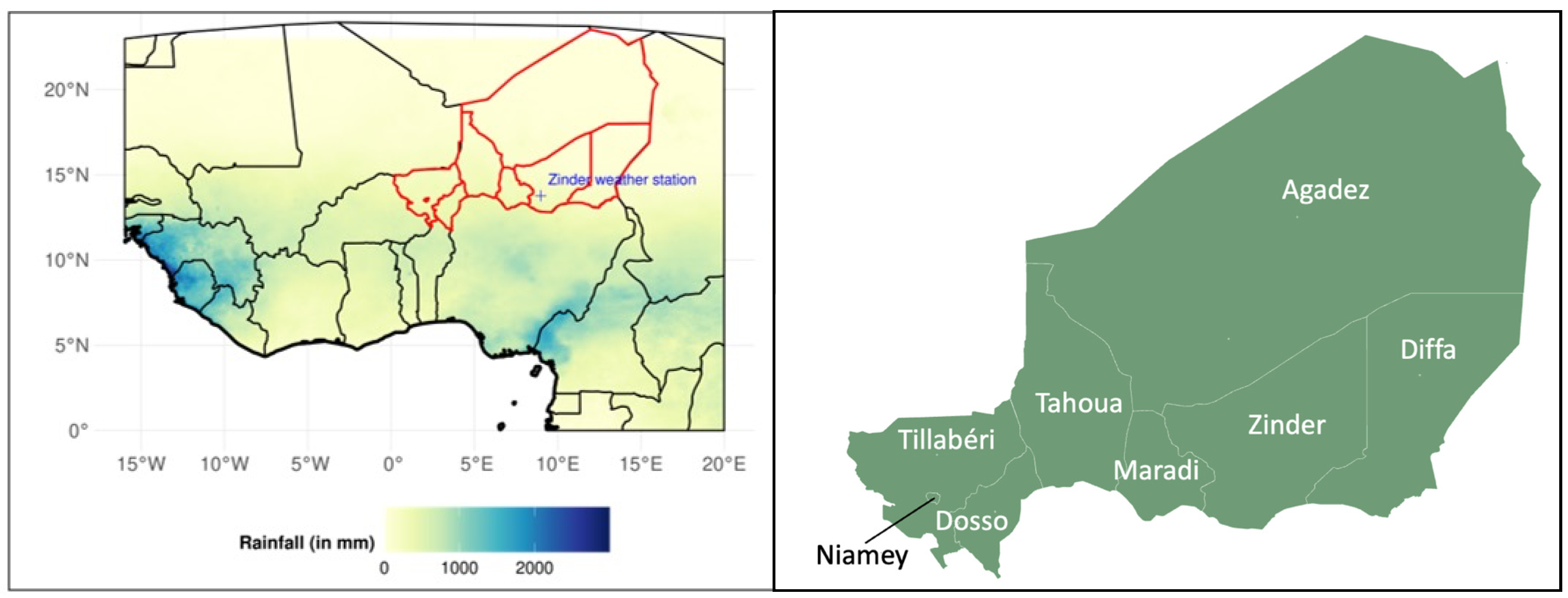
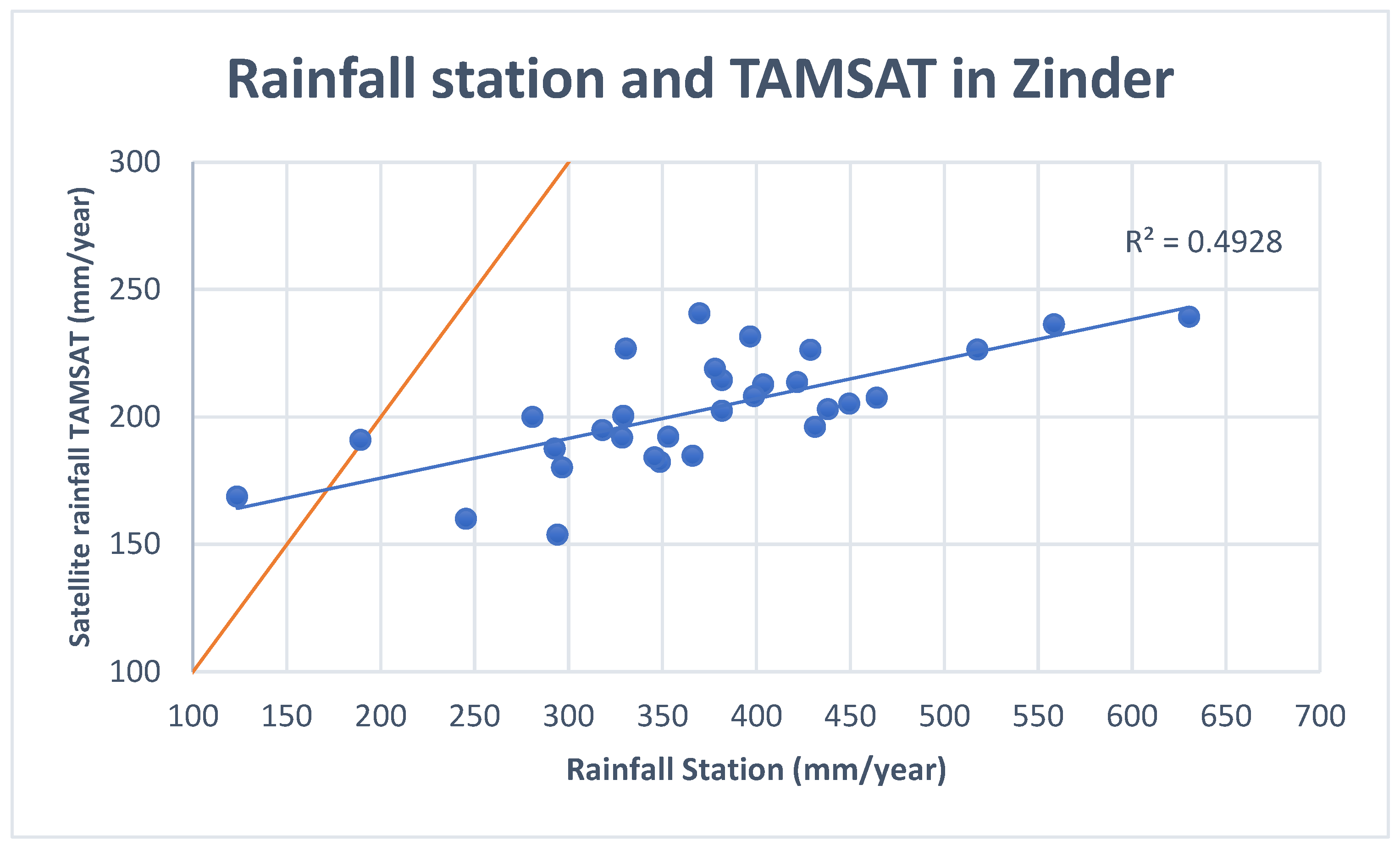
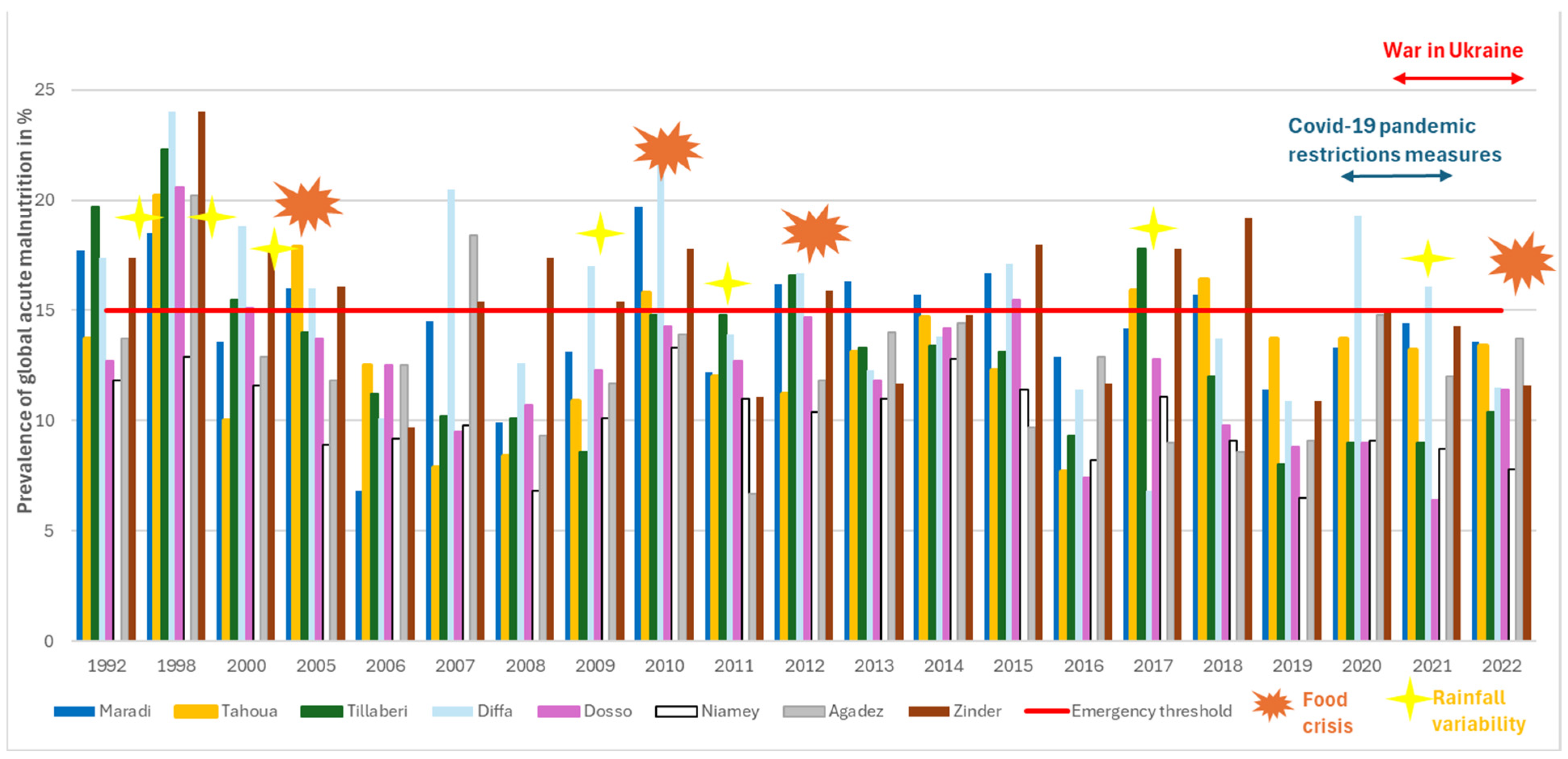
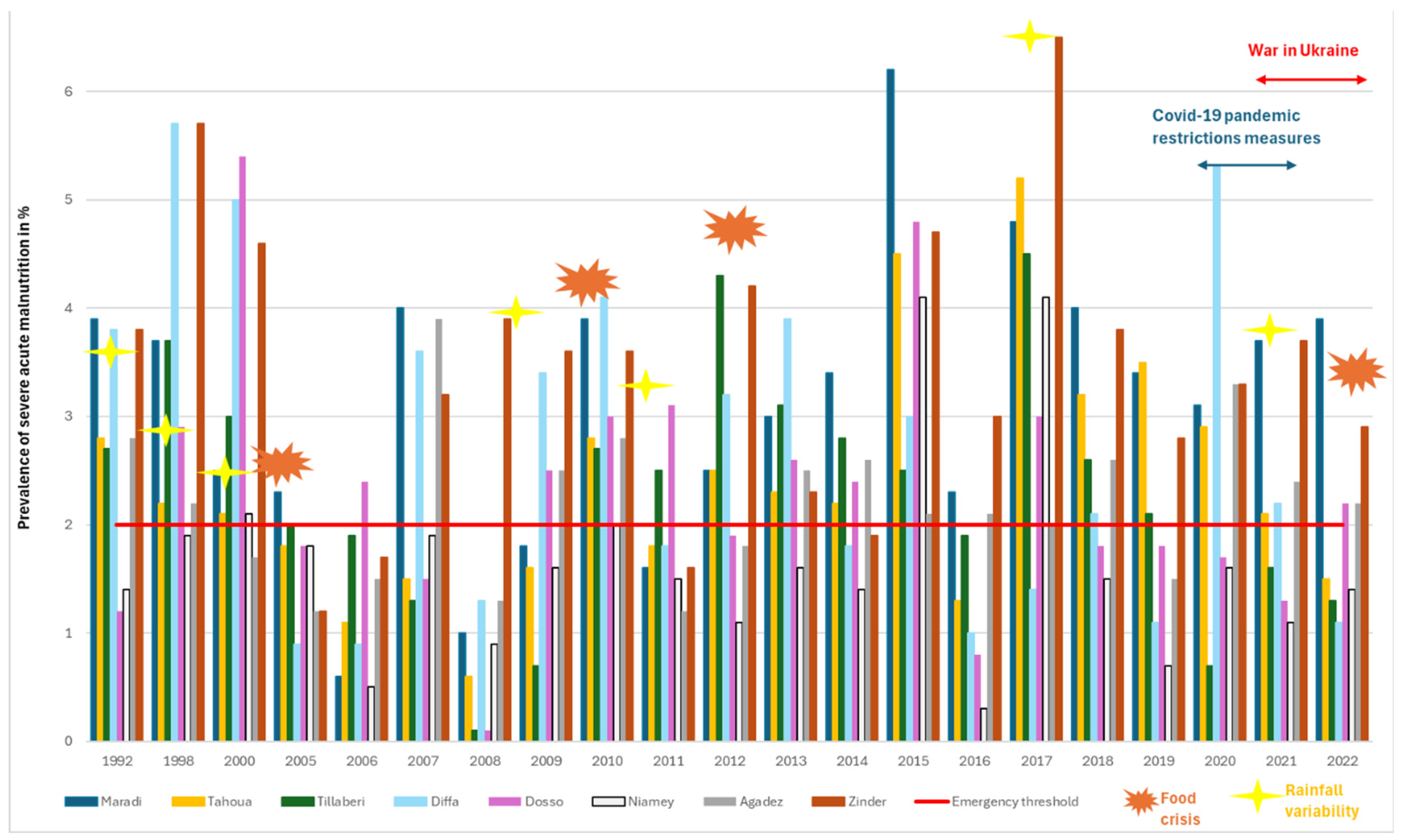
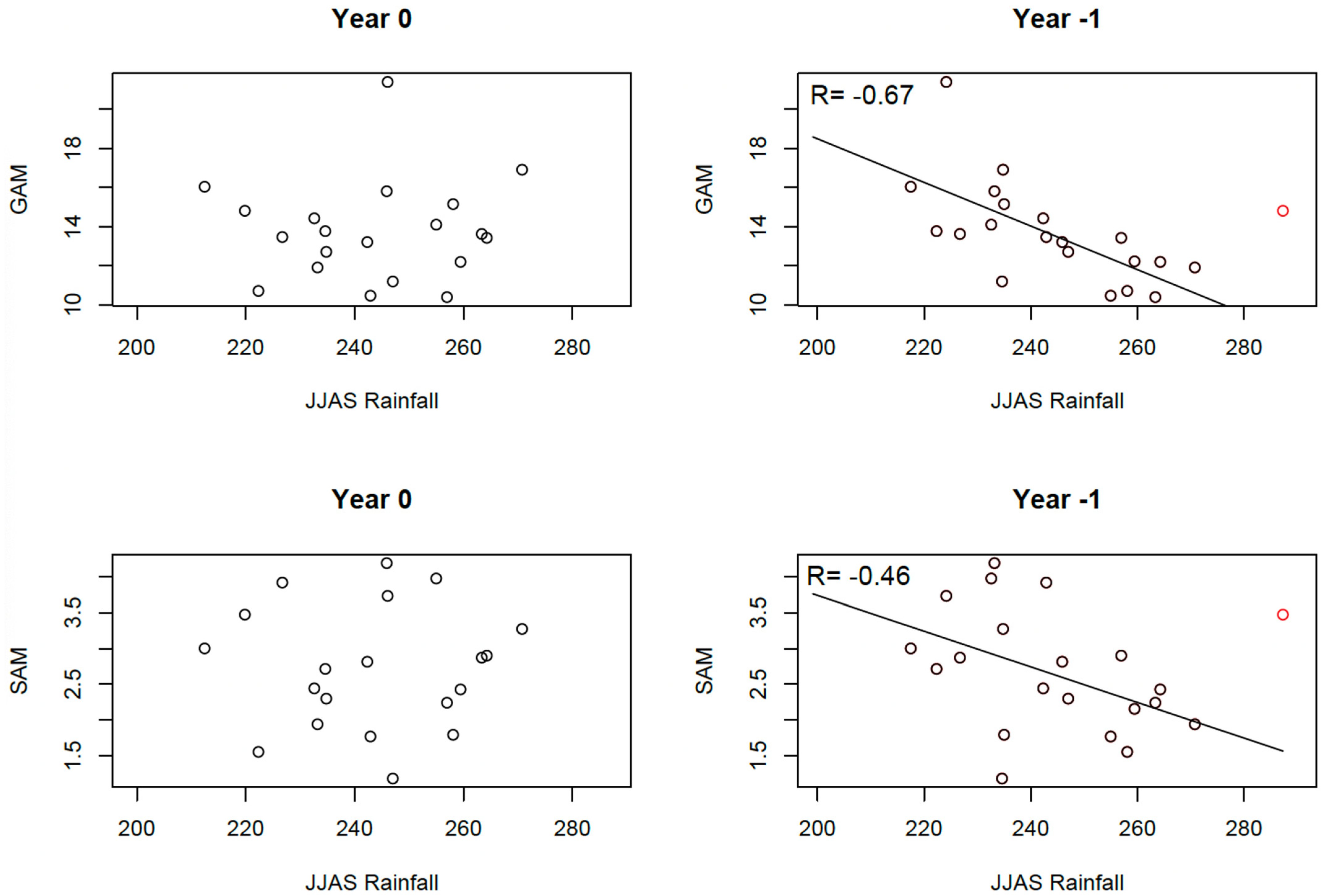
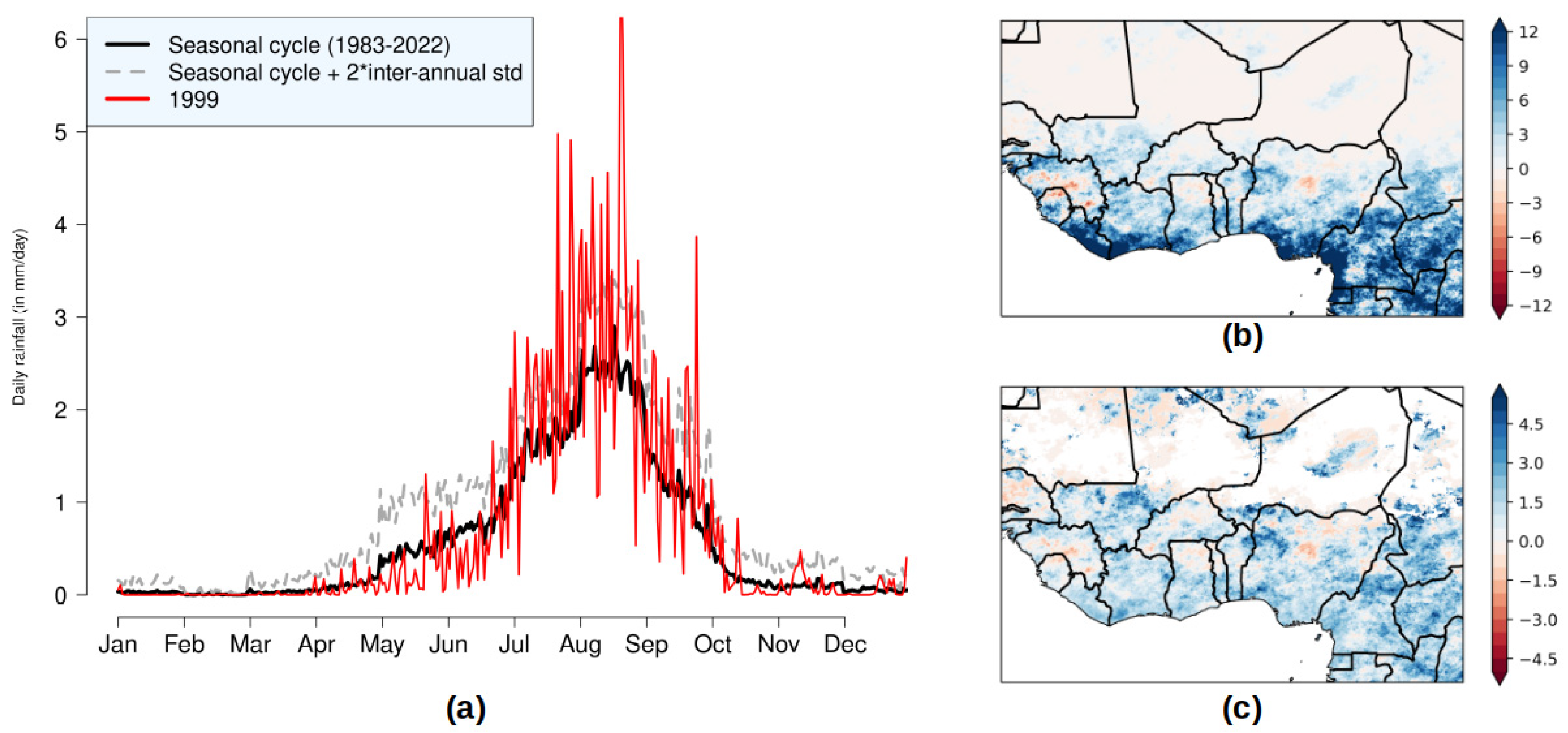

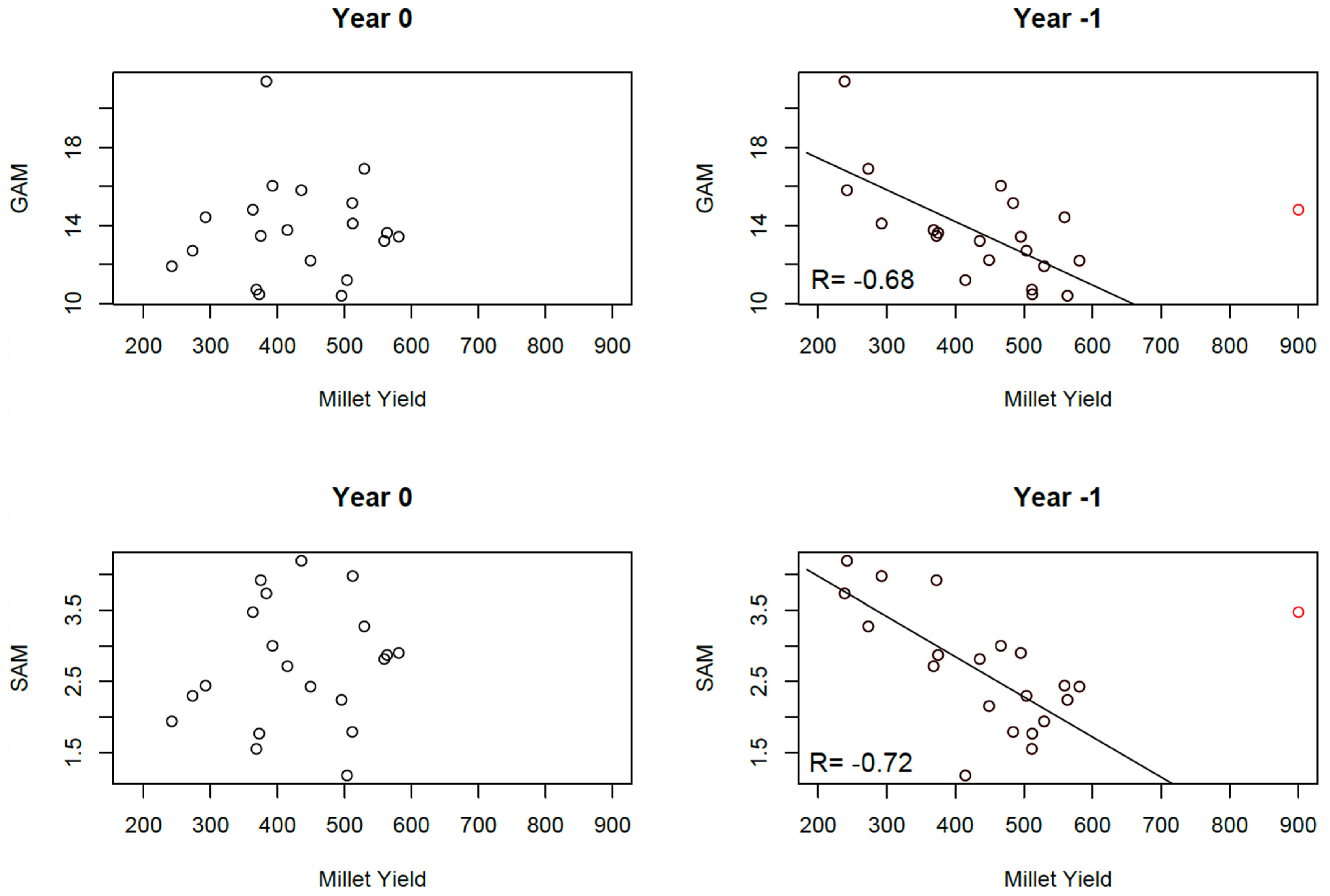
| Series Name | GAM | SAM | GAM (Detrended) | SAM (Detrended) |
|---|---|---|---|---|
| Population, total | −0.52 | −0.06 | 0.12 | 0.16 |
| Population growth (annual %) | −0.12 | −0.07 | −0.11 | −0.06 |
| Surface area (sq. km) | NA | NA | NA | NA |
| Population density (people per sq. km of land area) | −0.52 | −0.06 | 0.12 | 0.16 |
| Poverty headcount ratio at national poverty lines (% of population) | NA | NA | NA | NA |
| Poverty headcount ratio at USD 2.15 a day (2017 PPP) (% of population) | 0.74 | −0.09 | 0.10 | −0.66 |
| GNI, Atlas method (current USD) | −0.49 | −0.03 | 0.12 | 0.18 |
| GNI per capita, Atlas method (current USD) | −0.46 | −0.03 | −0.01 | 0.09 |
| GNI, PPP (current USD) | −0.48 | −0.08 | 0.10 | 0.02 |
| GNI per capita, PPP (current USD) | −0.49 | −0.11 | 0.08 | −0.06 |
| Income share held by lowest 20% | −0.76 | 0.16 | −0.73 | 0.24 |
| Life expectancy at birth, total (years) | −0.55 | −0.09 | −0.08 | 0.01 |
| Fertility rate, total (births per woman) | 0.49 | 0.05 | −0.08 | −0.09 |
| Adolescent fertility rate (births per 1000 women ages 15–19) | 0.41 | 0.00 | −0.16 | −0.16 |
| Contraceptive prevalence, any method (% of married women ages 15–49) | −0.47 | 0.13 | −0.14 | 0.26 |
| Births attended by skilled health staff (% of total) | −0.47 | −0.10 | 0.30 | 0.25 |
| Mortality rate, under 5 (per 1000 live births) | 0.56 | 0.18 | 0.16 | 0.21 |
| Prevalence of underweight, weight for age (% of children under 5) | 0.76 | 0.49 | 0.64 | 0.49 |
| Immunization, measles (% of children ages 12–23 months) | −0.49 | 0.01 | −0.01 | 0.21 |
| Primary completion rate, total (% of relevant age group) | −0.53 | 0.00 | −0.10 | 0.19 |
| School enrollment, primary (% gross) | −0.52 | −0.02 | −0.06 | 0.17 |
| School enrollment, secondary (% gross) | −0.42 | 0.13 | 0.03 | 0.31 |
| School enrollment, primary and secondary (gross), gender parity index (GPI) | −0.43 | 0.04 | 0.43 | 0.31 |
| Prevalence of HIV, total (% of population ages 15–49) | 0.59 | 0.12 | 0.29 | 0.07 |
| Forest area (sq. km) | 0.51 | 0.13 | 0.03 | 0.10 |
| Terrestrial and marine protected areas (% of total territorial area) | 0.24 | −0.16 | 0.22 | 0.03 |
| Annual freshwater withdrawals, total (% of internal resources) | −0.45 | −0.03 | 0.06 | 0.04 |
| Urban population growth (annual %) | −0.09 | 0.27 | 0.29 | 0.38 |
| Energy use (kg of oil equivalent per capita) | 0.26 | 0.25 | 0.30 | 0.24 |
| Electric power consumption (kWh per capita) | 0.22 | 0.32 | 0.43 | 0.64 |
| GDP (current USD) | −0.49 | −0.07 | 0.12 | 0.07 |
| GDP growth (annual %) | 0.24 | 0.01 | 0.40 | 0.03 |
| Inflation, GDP deflator (annual %) | 0.09 | −0.24 | 0.08 | −0.21 |
| Agriculture, forestry, and fishing, value added (% of GDP) | −0.28 | −0.48 | −0.20 | −0.46 |
| Industry (including construction), value added (% of GDP) | 0.07 | 0.34 | 0.13 | 0.34 |
| Exports of goods and services (% of GDP) | 0.33 | 0.21 | 0.14 | 0.18 |
| Imports of goods and services (% of GDP) | −0.15 | 0.01 | 0.09 | 0.05 |
| Gross capital formation (% of GDP) | −0.42 | −0.08 | 0.07 | 0.00 |
| Revenue, excluding grants (% of GDP) | NA | NA | NA | NA |
| Time required to start a business (days) | 0.13 | −0.42 | 0.05 | 0.05 |
| Domestic credit provided by financial sector (% of GDP) | NA | NA | NA | NA |
| Tax revenue (% of GDP) | NA | NA | NA | NA |
| Military expenditure (% of GDP) | −0.26 | 0.31 | 0.22 | 0.54 |
| Mobile cellular subscriptions (per 100 people) | −0.40 | 0.11 | 0.28 | 0.42 |
| High-technology exports (% of manufactured exports) | 0.16 | −0.02 | 0.14 | −0.03 |
| Merchandise trade (% of GDP) | 0.00 | 0.01 | 0.10 | 0.02 |
| Net barter terms of trade index (2015 = 100) | −0.46 | −0.13 | −0.20 | −0.12 |
| External debt stocks, total (DOD, current USD) | −0.26 | 0.02 | 0.23 | 0.11 |
| Total debt service (% of exports of goods, services and primary income) | −0.05 | −0.15 | −0.09 | −0.14 |
| Net migration | 0.06 | 0.37 | 0.22 | 0.40 |
| Personal remittances, received (current USD) | −0.36 | −0.09 | 0.15 | −0.02 |
| Foreign direct investment, net inflows (BoP, current USD) | −0.26 | 0.00 | 0.11 | 0.07 |
| Net official development assistance and official aid received (current USD) | −0.38 | −0.04 | 0.20 | 0.09 |
| GAM | With 1999 | Without 1999 |
|---|---|---|
| year n − 1 | ||
| JJAS rainfall | −0.51 | −0.67 |
| Onset | −0.28 | −0.38 |
| Duration | 0.25 | 0.32 |
| Cessation | −0.11 | −0.14 |
| Dry spells | −0.04 | −0.10 |
| Tmean | 0.30 | 0.28 |
| Tmin | 0.22 | 0.20 |
| Tmax | 0.34 | 0.32 |
| Tx90p | 0.22 | 0.19 |
| Tn90p | 0.27 | 0.25 |
| Wsdi | −0.14 | −0.16 |
| SAM | With 1999 | Without 1999 |
| year n − 1 | ||
| JJAS rainfall | −0.27 | −0.46 |
| Onset | −0.21 | −0.21 |
| Duration | 0.35 | 0.35 |
| Cessation | 0.14 | 0.14 |
| Dry spells | 0.16 | 0.16 |
| Tmean | 0.19 | 0.24 |
| Tmin | 0.21 | 0.26 |
| Tmax | 0.16 | 0.20 |
| Tx90p | 0.14 | 0.22 |
| Tn90p | −0.07 | −0.01 |
| Wsdi | −0.29 | −0.25 |
| GAM | SAM | ||
|---|---|---|---|
| year n − 1 | year n − 1 | ||
| Zinder | JJAS rainfall | −0.58 | −0.20 |
| Onset | −0.20 | 0.06 | |
| Duration | 0.05 | 0.01 | |
| Cessation | −0.32 | 0.13 | |
| Dry spells | 0.16 | 0.39 | |
| Maradi | JJAS rainfall | −0.25 | −0.14 |
| Onset | −0.43 | −0.17 | |
| Duration | 0.33 | 0.14 | |
| Cessation | −0.27 | −0.09 | |
| Dry spells | 0.32 | 0.04 | |
| Tillaberi | JJAS rainfall | −0.60 | −0.37 |
| Onset | −0.56 | −0.23 | |
| Duration | 0.46 | 0.44 | |
| Cessation | −0.12 | 0.27 | |
| Dry spells | −0.24 | −0.36 | |
| Tahoua | JJAS rainfall | −0.28 | −0.09 |
| Onset | −0.44 | −0.37 | |
| Duration | 0.29 | 0.50 | |
| Cessation | −0.36 | 0.11 | |
| Dry spells | −0.32 | −0.22 | |
| Diffa | JJAS rainfall | −0.53 | −0.17 |
| Onset | −0.21 | −0.33 | |
| Duration | 0.49 | 0.48 | |
| Cessation | 0.53 | 0.30 | |
| Dry spells | −0.45 | −0.20 | |
| Dosso | JJAS rainfall | −0.39 | −0.11 |
| Onset | −0.28 | 0.30 | |
| Duration | 0.36 | −0.08 | |
| Cessation | 0.09 | 0.39 | |
| Dry spells | 0.11 | 0.36 | |
| Agadez | JJAS rainfall | −0.44 | −0.33 |
| Onset | 0.20 | −0.01 | |
| Duration | −0.13 | 0.10 | |
| Cessation | −0.08 | 0.11 | |
| Dry spells | 0.20 | 0.00 |
| GAM | SAM | |
|---|---|---|
| year n + 1 (w/o 1999) | year n + 1 (w/o 1999) | |
| Zinder | −0.72 | −0.51 |
| Maradi | −0.51 | −0.28 |
| Tillaberi | −0.62 | −0.27 |
| Tahoua | −0.45 | 0.27 |
| Diffa | −0.50 | −0.10 |
| Dosso | −0.57 | 0.27 |
| Agadez | −0.37 | −0.37 |
| Synchronous Correlation | |
|---|---|
| Zinder | 0.80 |
| Maradi | 0.73 |
| Tillaberi | 0.82 |
| Tahoua | 0.69 |
| Diffa | 0.82 |
| Dosso | 0.74 |
| Agadez | 0.62 |
Disclaimer/Publisher’s Note: The statements, opinions and data contained in all publications are solely those of the individual author(s) and contributor(s) and not of MDPI and/or the editor(s). MDPI and/or the editor(s) disclaim responsibility for any injury to people or property resulting from any ideas, methods, instructions or products referred to in the content. |
© 2025 by the authors. Licensee MDPI, Basel, Switzerland. This article is an open access article distributed under the terms and conditions of the Creative Commons Attribution (CC BY) license (https://creativecommons.org/licenses/by/4.0/).
Share and Cite
Sultan, B.; Barriquault, A.; Brouillet, A.; Lavarenne, J.; Pongsiri, M. Malnutrition and Climate in Niger: Findings from Climate Indices and Crop Yield Simulations. Int. J. Environ. Res. Public Health 2025, 22, 551. https://doi.org/10.3390/ijerph22040551
Sultan B, Barriquault A, Brouillet A, Lavarenne J, Pongsiri M. Malnutrition and Climate in Niger: Findings from Climate Indices and Crop Yield Simulations. International Journal of Environmental Research and Public Health. 2025; 22(4):551. https://doi.org/10.3390/ijerph22040551
Chicago/Turabian StyleSultan, Benjamin, Aurélien Barriquault, Audrey Brouillet, Jérémy Lavarenne, and Montira Pongsiri. 2025. "Malnutrition and Climate in Niger: Findings from Climate Indices and Crop Yield Simulations" International Journal of Environmental Research and Public Health 22, no. 4: 551. https://doi.org/10.3390/ijerph22040551
APA StyleSultan, B., Barriquault, A., Brouillet, A., Lavarenne, J., & Pongsiri, M. (2025). Malnutrition and Climate in Niger: Findings from Climate Indices and Crop Yield Simulations. International Journal of Environmental Research and Public Health, 22(4), 551. https://doi.org/10.3390/ijerph22040551






